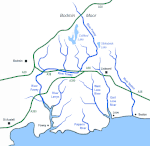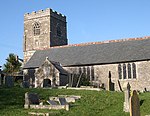Golant
Villages in Cornwall

Golant (Cornish: Golnans) is a village in south Cornwall, England, United Kingdom. It is on the west bank of the River Fowey and in the civil parish of St Sampson.Golant is about two miles (3 km) north of Fowey and seven miles (11 km) east of St Austell.Golant church is dedicated to St Sampson of Dol. The poet John Betjeman remarked that its pews were "extremely uncomfortable, recall the fidgets of Gus and Flora in Ravenshoe". The church was mentioned in the book England’s Thousand Best Churches by Simon Jenkins.The village is on the Saints' Way long-distance footpath.
Excerpt from the Wikipedia article Golant (License: CC BY-SA 3.0, Authors, Images).Golant
Water Lane,
Geographical coordinates (GPS) Address Nearby Places Show on map
Geographical coordinates (GPS)
| Latitude | Longitude |
|---|---|
| N 50.3629 ° | E -4.6416 ° |
Address
Water Lane
Water Lane
PL23 1LF , St. Sampson
England, United Kingdom
Open on Google Maps










